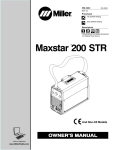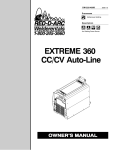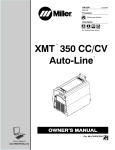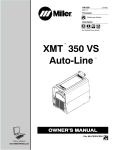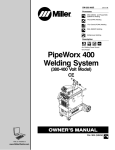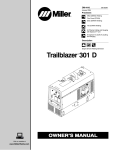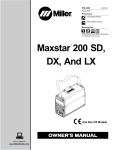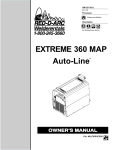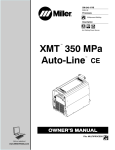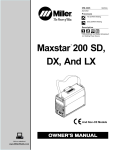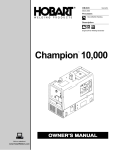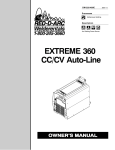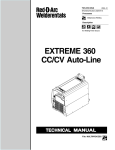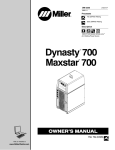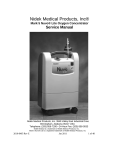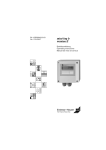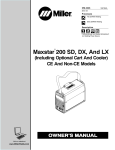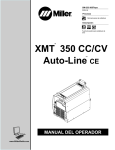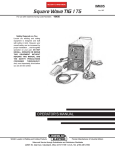Download Miller Electric CST 250 User's Manual
Transcript
OM-2237 206 035H July 2005 Processes Stick (SMAW) Welding TIG (GTAW) Welding Description Arc Welding Power Source CST 250 Visit our website at www.MillerWelds.com From Miller to You Thank you and congratulations on choosing Miller. Now you can get the job done and get it done right. We know you don’t have time to do it any other way. That’s why when Niels Miller first started building arc welders in 1929, he made sure his products offered long-lasting value and superior quality. Like you, his customers couldn’t afford anything less. Miller products had to be more than the best they could be. They had to be the best you could buy. Today, the people that build and sell Miller products continue the tradition. They’re just as committed to providing equipment and service that meets the high standards of quality and value established in 1929. This Owner’s Manual is designed to help you get the most out of your Miller products. Please take time to read the Safety precautions. They will help you protect yourself against potential hazards on the worksite. We’ve made installation and operation quick and easy. With Miller you can count on years of reliable service with proper maintenance. And if for some reason the unit needs repair, there’s a Troubleshooting section that will help you figure out what the problem is. The Miller is the first welding parts list will then help you to decide the equipment manufacturer in exact part you may need to fix the problem. the U.S.A. to be registered to the ISO 9001:2000 Quality Warranty and service information for your System Standard. particular model are also provided. Miller Electric manufactures a full line of welders and welding related equipment. For information on other quality Miller products, contact your local Miller distributor to receive the latest full line catalog or individual catalog sheets. To locate your nearest distributor or service agency call 1-800-4-A-Miller, or visit us at www.MillerWelds.com on the web. Mil_Thank 7/03 Working as hard as you do − every power source from Miller is backed by the most hassle-free warranty in the business. TABLE OF CONTENTS SECTION 1 − SAFETY PRECAUTIONS - READ BEFORE USING . . . . . . . . . . . . . . . . . . . . . . . . . . . . . . . . . 1-1. Symbol Usage . . . . . . . . . . . . . . . . . . . . . . . . . . . . . . . . . . . . . . . . . . . . . . . . . . . . . . . . . . . . . . . . . . . . . . . 1-2. Arc Welding Hazards . . . . . . . . . . . . . . . . . . . . . . . . . . . . . . . . . . . . . . . . . . . . . . . . . . . . . . . . . . . . . . . . . 1-3. Additional Symbols For Installation, Operation, And Maintenance . . . . . . . . . . . . . . . . . . . . . . . . . . . . 1-4. California Proposition 65 Warnings . . . . . . . . . . . . . . . . . . . . . . . . . . . . . . . . . . . . . . . . . . . . . . . . . . . . . . 1-5. Principal Safety Standards . . . . . . . . . . . . . . . . . . . . . . . . . . . . . . . . . . . . . . . . . . . . . . . . . . . . . . . . . . . . 1-6. EMF Information . . . . . . . . . . . . . . . . . . . . . . . . . . . . . . . . . . . . . . . . . . . . . . . . . . . . . . . . . . . . . . . . . . . . . SECTION 2 − CONSIGNES DE SÉCURITÉ − À LIRE AVANT UTILISATION . . . . . . . . . . . . . . . . . . . . . . . . 2-1. Signification des symboles . . . . . . . . . . . . . . . . . . . . . . . . . . . . . . . . . . . . . . . . . . . . . . . . . . . . . . . . . . . . 2-2. Dangers relatifs au soudage à l’arc . . . . . . . . . . . . . . . . . . . . . . . . . . . . . . . . . . . . . . . . . . . . . . . . . . . . . 2-3. Autres symboles relatifs à l’installation, au fonctionnement et à l’entretien de l’appareil. . . . . . . . . . . 2-4. Principales normes de sécurité . . . . . . . . . . . . . . . . . . . . . . . . . . . . . . . . . . . . . . . . . . . . . . . . . . . . . . . . . 2-5. Information sur les champs électromagnétiques . . . . . . . . . . . . . . . . . . . . . . . . . . . . . . . . . . . . . . . . . . . SECTION 3 − INSTALLATION . . . . . . . . . . . . . . . . . . . . . . . . . . . . . . . . . . . . . . . . . . . . . . . . . . . . . . . . . . . . . . . . 3-1. Specifications . . . . . . . . . . . . . . . . . . . . . . . . . . . . . . . . . . . . . . . . . . . . . . . . . . . . . . . . . . . . . . . . . . . . . . . 3-2. Duty Cycle And Overheating . . . . . . . . . . . . . . . . . . . . . . . . . . . . . . . . . . . . . . . . . . . . . . . . . . . . . . . . . . . 3-3. Stick (SMAW) Volt-Ampere Curves . . . . . . . . . . . . . . . . . . . . . . . . . . . . . . . . . . . . . . . . . . . . . . . . . . . . . 3-4. TIG (GTAW) Volt-Ampere Curve . . . . . . . . . . . . . . . . . . . . . . . . . . . . . . . . . . . . . . . . . . . . . . . . . . . . . . . . 3-5. Selecting A Location . . . . . . . . . . . . . . . . . . . . . . . . . . . . . . . . . . . . . . . . . . . . . . . . . . . . . . . . . . . . . . . . . . 3-6. Weld Output Terminals And Selecting Cable Sizes* . . . . . . . . . . . . . . . . . . . . . . . . . . . . . . . . . . . . . . . . 3-7. TIG Lift-Arct DCEN (Direct Current Electrode Negative) Connections . . . . . . . . . . . . . . . . . . . . . . . . . 3-8. Stick DCEP (Direct Current Electrode Positive) Connections . . . . . . . . . . . . . . . . . . . . . . . . . . . . . . . . 3-9. Electrical Service Guide . . . . . . . . . . . . . . . . . . . . . . . . . . . . . . . . . . . . . . . . . . . . . . . . . . . . . . . . . . . . . . . 3-10. Selecting 230 Volts AC Single/Three Phase Input Voltage . . . . . . . . . . . . . . . . . . . . . . . . . . . . . . . . . . . 3-11. Selecting 460 - 575 Volts AC Three Phase Input Voltage . . . . . . . . . . . . . . . . . . . . . . . . . . . . . . . . . . . . 3-12. Connecting Input Power . . . . . . . . . . . . . . . . . . . . . . . . . . . . . . . . . . . . . . . . . . . . . . . . . . . . . . . . . . . . . . . SECTION 4 − OPERATION . . . . . . . . . . . . . . . . . . . . . . . . . . . . . . . . . . . . . . . . . . . . . . . . . . . . . . . . . . . . . . . . . . 4-1. Controls . . . . . . . . . . . . . . . . . . . . . . . . . . . . . . . . . . . . . . . . . . . . . . . . . . . . . . . . . . . . . . . . . . . . . . . . . . . . 4-2. Process Select Control . . . . . . . . . . . . . . . . . . . . . . . . . . . . . . . . . . . . . . . . . . . . . . . . . . . . . . . . . . . . . . . 4-3. Stick Start Procedure − Scratch Start Technique . . . . . . . . . . . . . . . . . . . . . . . . . . . . . . . . . . . . . . . . . . 4-4. Lift-ArcE Start Procedure . . . . . . . . . . . . . . . . . . . . . . . . . . . . . . . . . . . . . . . . . . . . . . . . . . . . . . . . . . . . . . 4-5. Amperage Control . . . . . . . . . . . . . . . . . . . . . . . . . . . . . . . . . . . . . . . . . . . . . . . . . . . . . . . . . . . . . . . . . . . . 4-6. Remote 14 Receptacle Information . . . . . . . . . . . . . . . . . . . . . . . . . . . . . . . . . . . . . . . . . . . . . . . . . . . . . . 4-7. Fan-On-Demand . . . . . . . . . . . . . . . . . . . . . . . . . . . . . . . . . . . . . . . . . . . . . . . . . . . . . . . . . . . . . . . . . . . . . 4-8. Rack Mounting . . . . . . . . . . . . . . . . . . . . . . . . . . . . . . . . . . . . . . . . . . . . . . . . . . . . . . . . . . . . . . . . . . . . . . SECTION 5 − MAINTENANCE AND TROUBLESHOOTING . . . . . . . . . . . . . . . . . . . . . . . . . . . . . . . . . . . . . . 5-1. Routine Maintenance . . . . . . . . . . . . . . . . . . . . . . . . . . . . . . . . . . . . . . . . . . . . . . . . . . . . . . . . . . . . . . . . . 5-2. Blowing Out Inside Of Unit . . . . . . . . . . . . . . . . . . . . . . . . . . . . . . . . . . . . . . . . . . . . . . . . . . . . . . . . . . . . . 5-3. Troubleshooting . . . . . . . . . . . . . . . . . . . . . . . . . . . . . . . . . . . . . . . . . . . . . . . . . . . . . . . . . . . . . . . . . . . . . SECTION 6 − ELECTRICAL DIAGRAMS . . . . . . . . . . . . . . . . . . . . . . . . . . . . . . . . . . . . . . . . . . . . . . . . . . . . . . SECTION 7 − SELECTING AND PREPARING TUNGSTEN ELECTRODE . . . . . . . . . . . . . . . . . . . . . . . . . . 7-1. Selecting Tungsten Electrode . . . . . . . . . . . . . . . . . . . . . . . . . . . . . . . . . . . . . . . . . . . . . . . . . . . . . . . . . . 7-2. Safety Information About Tungsten . . . . . . . . . . . . . . . . . . . . . . . . . . . . . . . . . . . . . . . . . . . . . . . . . . . . . . 7-3. Preparing Tungsten For AC Or DC Electrode Negative (DCEN) Welding . . . . . . . . . . . . . . . . . . . . . . SECTION 8 − PARTS LIST . . . . . . . . . . . . . . . . . . . . . . . . . . . . . . . . . . . . . . . . . . . . . . . . . . . . . . . . . . . . . . . . . . . OPTIONS AND ACCESSORIES WARRANTY 1 1 1 3 3 4 4 5 5 5 7 8 8 9 9 9 10 11 12 13 14 15 15 16 17 18 19 19 20 21 21 22 22 22 22 23 23 23 24 26 27 27 27 28 30 SECTION 1 − SAFETY PRECAUTIONS - READ BEFORE USING som _8/03 1-1. Symbol Usage Means Warning! Watch Out! There are possible hazards with this procedure! The possible hazards are shown in the adjoining symbols. Marks a special safety message. Means “Note”; not safety related. This group of symbols means Warning! Watch Out! possible ELECTRIC SHOCK, MOVING PARTS, and HOT PARTS hazards. Consult symbols and related instructions below for necessary actions to avoid the hazards. 1-2. Arc Welding Hazards The symbols shown below are used throughout this manual to call attention to and identify possible hazards. When you see the symbol, watch out, and follow the related instructions to avoid the hazard. The safety information given below is only a summary of the more complete safety information found in the Safety Standards listed in Section 1-5. Read and follow all Safety Standards. If earth grounding of the workpiece is required, ground it directly with a separate cable. Only qualified persons should install, operate, maintain, and repair this unit. Wear a safety harness if working above floor level. Keep all panels and covers securely in place. During operation, keep everybody, especially children, away. Clamp work cable with good metal-to-metal contact to workpiece or worktable as near the weld as practical. ELECTRIC SHOCK can kill. Touching live electrical parts can cause fatal shocks or severe burns. The electrode and work circuit is electrically live whenever the output is on. The input power circuit and machine internal circuits are also live when power is on. In semiautomatic or automatic wire welding, the wire, wire reel, drive roll housing, and all metal parts touching the welding wire are electrically live. Incorrectly installed or improperly grounded equipment is a hazard. Do not touch electrode if you are in contact with the work, ground, or another electrode from a different machine. Use only well-maintained equipment. Repair or replace damaged parts at once. Maintain unit according to manual. Insulate work clamp when not connected to workpiece to prevent contact with any metal object. Do not connect more than one electrode or work cable to any single weld output terminal. SIGNIFICANT DC VOLTAGE exists after removal of input power on inverters. Turn Off inverter, disconnect input power, and discharge input capacitors according to instructions in Maintenance Section before touching any parts. Do not touch live electrical parts. Wear dry, hole-free insulating gloves and body protection. Insulate yourself from work and ground using dry insulating mats or covers big enough to prevent any physical contact with the work or ground. Do not use AC output in damp areas, if movement is confined, or if there is a danger of falling. Use AC output ONLY if required for the welding process. If AC output is required, use remote output control if present on unit. Disconnect input power or stop engine before installing or servicing this equipment. Lockout/tagout input power according to OSHA 29 CFR 1910.147 (see Safety Standards). Properly install and ground this equipment according to its Owner’s Manual and national, state, and local codes. Keep your head out of the fumes. Do not breathe the fumes. Always verify the supply ground − check and be sure that input power cord ground wire is properly connected to ground terminal in disconnect box or that cord plug is connected to a properly grounded receptacle outlet. When making input connections, attach proper grounding conductor first − double-check connections. Frequently inspect input power cord for damage or bare wiring − replace cord immediately if damaged − bare wiring can kill. Turn off all equipment when not in use. Do not use worn, damaged, undersized, or poorly spliced cables. Do not weld in locations near degreasing, cleaning, or spraying operations. The heat and rays of the arc can react with vapors to form highly toxic and irritating gases. Do not drape cables over your body. FUMES AND GASES can be hazardous. Welding produces fumes and gases. Breathing these fumes and gases can be hazardous to your health. If inside, ventilate the area and/or use exhaust at the arc to remove welding fumes and gases. If ventilation is poor, use an approved air-supplied respirator. Read the Material Safety Data Sheets (MSDSs) and the manufacturer’s instructions for metals, consumables, coatings, cleaners, and degreasers. Work in a confined space only if it is well ventilated, or while wearing an air-supplied respirator. Always have a trained watchperson nearby. Welding fumes and gases can displace air and lower the oxygen level causing injury or death. Be sure the breathing air is safe. Do not weld on coated metals, such as galvanized, lead, or cadmium plated steel, unless the coating is removed from the weld area, the area is well ventilated, and if necessary, while wearing an air-supplied respirator. The coatings and any metals containing these elements can give off toxic fumes if welded. OM-2237 Page 1 ARC RAYS can burn eyes and skin. Arc rays from the welding process produce intense visible and invisible (ultraviolet and infrared) rays that can burn eyes and skin. Sparks fly off from the weld. Wear a welding helmet fitted with a proper shade of filter to protect your face and eyes when welding or watching (see ANSI Z49.1 and Z87.1 listed in Safety Standards). Wear approved safety glasses with side shields under your helmet. Use protective screens or barriers to protect others from flash and glare; warn others not to watch the arc. Wear protective clothing made from durable, flame-resistant material (leather and wool) and foot protection. BUILDUP OF GAS can injure or kill. Shut off shielding gas supply when not in use. Always ventilate confined spaces or use approved air-supplied respirator. HOT PARTS can cause severe burns. Do not touch hot parts bare handed. Allow cooling period before working on gun or torch. MAGNETIC FIELDS can affect pacemakers. WELDING can cause fire or explosion. Welding on closed containers, such as tanks, drums, or pipes, can cause them to blow up. Sparks can fly off from the welding arc. The flying sparks, hot workpiece, and hot equipment can cause fires and burns. Accidental contact of electrode to metal objects can cause sparks, explosion, overheating, or fire. Check and be sure the area is safe before doing any welding. Protect yourself and others from flying sparks and hot metal. Do not weld where flying sparks can strike flammable material. Remove all flammables within 35 ft (10.7 m) of the welding arc. If this is not possible, tightly cover them with approved covers. Be alert that welding sparks and hot materials from welding can easily go through small cracks and openings to adjacent areas. Watch for fire, and keep a fire extinguisher nearby. Be aware that welding on a ceiling, floor, bulkhead, or partition can cause fire on the hidden side. Do not weld on closed containers such as tanks, drums, or pipes, unless they are properly prepared according to AWS F4.1 (see Safety Standards). Connect work cable to the work as close to the welding area as practical to prevent welding current from traveling long, possibly unknown paths and causing electric shock and fire hazards. Do not use welder to thaw frozen pipes. Remove stick electrode from holder or cut off welding wire at contact tip when not in use. Wear oil-free protective garments such as leather gloves, heavy shirt, cuffless trousers, high shoes, and a cap. Remove any combustibles, such as a butane lighter or matches, from your person before doing any welding. FLYING METAL can injure eyes. Welding, chipping, wire brushing, and grinding cause sparks and flying metal. As welds cool, they can throw off slag. Wear approved safety glasses with side shields even under your welding helmet. OM-2237 Page 2 Pacemaker wearers keep away. Wearers should consult their doctor before going near arc welding, gouging, or spot welding operations. NOISE can damage hearing. Noise from some processes or equipment can damage hearing. Wear approved ear protection if noise level is high. CYLINDERS can explode if damaged. Shielding gas cylinders contain gas under high pressure. If damaged, a cylinder can explode. Since gas cylinders are normally part of the welding process, be sure to treat them carefully. Protect compressed gas cylinders from excessive heat, mechanical shocks, slag, open flames, sparks, and arcs. Install cylinders in an upright position by securing to a stationary support or cylinder rack to prevent falling or tipping. Keep cylinders away from any welding or other electrical circuits. Never drape a welding torch over a gas cylinder. Never allow a welding electrode to touch any cylinder. Never weld on a pressurized cylinder − explosion will result. Use only correct shielding gas cylinders, regulators, hoses, and fittings designed for the specific application; maintain them and associated parts in good condition. Turn face away from valve outlet when opening cylinder valve. Keep protective cap in place over valve except when cylinder is in use or connected for use. Read and follow instructions on compressed gas cylinders, associated equipment, and CGA publication P-1 listed in Safety Standards. 1-3. Additional Symbols For Installation, Operation, And Maintenance FIRE OR EXPLOSION hazard. MOVING PARTS can cause injury. Do not install or place unit on, over, or near combustible surfaces. Do not install unit near flammables. Do not overload building wiring − be sure power supply system is properly sized, rated, and protected to handle this unit. Keep away from moving parts such as fans. Keep all doors, panels, covers, and guards closed and securely in place. FALLING UNIT can cause injury. H.F. RADIATION can cause interference. Use lifting eye to lift unit only, NOT running gear, gas cylinders, or any other accessories. Use equipment of adequate capacity to lift and support unit. If using lift forks to move unit, be sure forks are long enough to extend beyond opposite side of unit. OVERUSE can cause OVERHEATING Allow cooling period; follow rated duty cycle. Reduce current or reduce duty cycle before starting to weld again. Do not block or filter airflow to unit. High-frequency (H.F.) can interfere with radio navigation, safety services, computers, and communications equipment. Have only qualified persons familiar with electronic equipment perform this installation. The user is responsible for having a qualified electrician promptly correct any interference problem resulting from the installation. If notified by the FCC about interference, stop using the equipment at once. Have the installation regularly checked and maintained. Keep high-frequency source doors and panels tightly shut, keep spark gaps at correct setting, and use grounding and shielding to minimize the possibility of interference. STATIC (ESD) can damage PC boards. Put on grounded wrist strap BEFORE handling boards or parts. Use proper static-proof bags and boxes to store, move, or ship PC boards. ARC WELDING can cause interference. MOVING PARTS can cause injury. Keep away from moving parts. Keep away from pinch points such as drive rolls. WELDING WIRE can cause injury. Do not press gun trigger until instructed to do so. Do not point gun toward any part of the body, other people, or any metal when threading welding wire. Electromagnetic energy can interfere with sensitive electronic equipment such as computers and computer-driven equipment such as robots. Be sure all equipment in the welding area is electromagnetically compatible. To reduce possible interference, keep weld cables as short as possible, close together, and down low, such as on the floor. Locate welding operation 100 meters from any sensitive electronic equipment. Be sure this welding machine is installed and grounded according to this manual. If interference still occurs, the user must take extra measures such as moving the welding machine, using shielded cables, using line filters, or shielding the work area. 1-4. California Proposition 65 Warnings Welding or cutting equipment produces fumes or gases which contain chemicals known to the State of California to cause birth defects and, in some cases, cancer. (California Health & Safety Code Section 25249.5 et seq.) For Gasoline Engines: Engine exhaust contains chemicals known to the State of California to cause cancer, birth defects, or other reproductive harm. Battery posts, terminals and related accessories contain lead and lead compounds, chemicals known to the State of California to cause cancer and birth defects or other reproductive harm. Wash hands after handling. For Diesel Engines: Diesel engine exhaust and some of its constituents are known to the State of California to cause cancer, birth defects, and other reproductive harm. OM-2237 Page 3 1-5. Principal Safety Standards Safety in Welding, Cutting, and Allied Processes, ANSI Standard Z49.1, from American Welding Society, 550 N.W. LeJeune Rd, Miami FL 33126 (phone: 305-443-9353, website: www.aws.org). Boulevard, Rexdale, Ontario, Canada M9W 1R3 (phone: 800−463−6727 or in Toronto 416−747−4044, website: www.csa−international.org). Recommended Safe Practices for the Preparation for Welding and Cutting of Containers and Piping, American Welding Society Standard AWS F4.1, from American Welding Society, 550 N.W. LeJeune Rd, Miami, FL 33126 (phone: 305-443-9353, website: www.aws.org). Practice For Occupational And Educational Eye And Face Protection, ANSI Standard Z87.1, from American National Standards Institute, 11 West 42nd Street, New York, NY 10036−8002 (phone: 212−642−4900, website: www.ansi.org). National Electrical Code, NFPA Standard 70, from National Fire Protection Association, P.O. Box 9101, 1 Battery March Park, Quincy, MA 02269−9101 (phone: 617−770−3000, website: www.nfpa.org and www. sparky.org). Standard for Fire Prevention During Welding, Cutting, and Other Hot Work, NFPA Standard 51B, from National Fire Protection Association, P.O. Box 9101, 1 Battery March Park, Quincy, MA 02269−9101 (phone: 617−770−3000,website: www.nfpa.org and www. sparky.org). Safe Handling of Compressed Gases in Cylinders, CGA Pamphlet P-1, from Compressed Gas Association, 1735 Jefferson Davis Highway, Suite 1004, Arlington, VA 22202−4102 (phone: 703−412−0900, website: www.cganet.com). Code for Safety in Welding and Cutting, CSA Standard W117.2, from Canadian Standards Association, Standards Sales, 178 Rexdale OSHA, Occupational Safety and Health Standards for General Industry, Title 29, Code of Federal Regulations (CFR), Part 1910, Subpart Q, and Part 1926, Subpart J, from U.S. Government Printing Office, Superintendent of Documents, P.O. Box 371954, Pittsburgh, PA 15250 (there are 10 Regional Offices−−phone for Region 5, Chicago, is 312−353−2220,website: www.osha.gov). 1-6. EMF Information Considerations About Welding And The Effects Of Low Frequency Electric And Magnetic Fields Welding current, as it flows through welding cables, will cause electromagnetic fields. There has been and still is some concern about such fields. However, after examining more than 500 studies spanning 17 years of research, a special blue ribbon committee of the National Research Council concluded that: “The body of evidence, in the committee’s judgment, has not demonstrated that exposure to powerfrequency electric and magnetic fields is a human-health hazard.” However, studies are still going forth and evidence continues to be examined. Until the final conclusions of the research are reached, you may wish to minimize your exposure to electromagnetic fields when welding or cutting. To reduce magnetic fields in the workplace, use the following procedures: OM-2237 Page 4 1. Keep cables close together by twisting or taping them. 2. Arrange cables to one side and away from the operator. 3. Do not coil or drape cables around your body. 4. Keep welding power source and cables as far away from operator as practical. 5. Connect work clamp to workpiece as close to the weld as possible. About Pacemakers: Pacemaker wearers consult your doctor first. If cleared by your doctor, then following the above procedures is recommended. SECTION 2 − CONSIGNES DE SÉCURITÉ − À LIRE AVANT UTILISATION som_fre 8/03 2-1. Signification des symboles Signifie « Mise en garde. Faire preuve de vigilance. » Cette procédure présente des risques identifiés par les symboles adjacents aux directives. Identifie un message de sécurité particulier. Signifie « NOTA » ; n’est pas relatif à la sécurité. Ce groupe de symboles signifie « Mise en garde. Faire preuve de vigilance. » Il y a des dangers liés aux CHOCS ÉLECTRIQUES, aux PIÈCES EN MOUVEMENT et aux PIÈCES CHAUDES. Se reporter aux symboles et aux directives ci-dessous afin de connaître les mesures à prendre pour éviter tout danger. 2-2. Dangers relatifs au soudage à l’arc Les symboles ci-après sont utilisés tout au long du présent manuel pour attirer l’attention sur les dangers potentiels et les identifier. Lorsqu’on voit un symbole, faire preuve de vigilance et suivre les directives mentionnées afin d’éviter tout danger. Les consignes de sécurité énoncées ci-après ne font que résumer le contenu des normes de sécurité mentionnées à la section 2-4. Lire et respecter toutes ces normes. L’installation, l’utilisation, l’entretien et les réparations ne doivent être confiés qu’à des personnes qualifiées. Pendant l’utilisation de l’appareil, tenir à l’écart toute personne, en particulier les enfants. LES DÉCHARGES ÉLECTRIQUES peuvent être mortelles. Un simple contact avec des pièces sous tension peut causer une électrocution ou des blessures graves. L’électrode et le circuit de soudage sont sous tension dès que l’appareil est en fonctionnement. Le circuit d’entrée et les circuits internes de l’appareil sont également sous tension. En soudage semi−automatique ou automatique, le fil, le dévidoir, le logement des galets d’entraînement et les pièces métalliques en contact avec le fil de soudage sont sous tension. Tout matériel mal installé ou mal mis à la terre présente un danger. Ne jamais toucher aux pièces électriques sous tension. Porter des gants et des vêtements de protection secs et exempts de trous. S’isoler de la pièce et de la terre au moyen de tapis ou autres dispositifs isolants suffisamment grands pour empêcher tout contact physique avec la pièce ou la terre. Ne pas se servir d’une source de courant alternatif dans les zones humides, les endroits confinés ou là où on risque de tomber. Ne se servir d’une source de courant alternatif QUE si le procédé de soudage l’exige. Si l’utilisation d’une source de courant alternatif s’avère nécessaire, se servir de la fonction de télécommande si l’appareil en est équipé. Couper l’alimentation ou arrêter le moteur avant de procéder à l’installation, à la réparation ou à l’entretien de l’appareil. Couper/étiqueter l’alimentation selon la norme OSHA 29 CFR 1910.147 (voir les normes de sécurité). Installer et mettre à la terre correctement l’appareil conformément à son manuel d’utilisation et aux codes nationaux, provinciaux et municipaux. Toujours vérifier la terre du cordon d’alimentation − Vérifier et s’assurer que le fil de terre du cordon d’alimentation est bien raccordé à la borne de terre du sectionneur ou que la fiche du cordon est raccordée à une prise correctement mise à la terre. Pour exécuter les branchements d’entrée, fixer d’abord le conducteur de mise à la terre adéquat et contre−vérifier les connexions. Vérifier fréquemment le cordon d’alimentation et s’assurer qu’il n’est ni endommagé ni dénudé ; le remplacer immédiatement s’il est endommagé − tout câble dénudé peut causer une électrocution. Mettre l’appareil hors tension quand on ne l’utilise pas. Ne pas utiliser de câbles usés, endommagés, de calibre insuffisant ou mal épissés. Ne pas s’enrouler les câbles autour du corps. Si la pièce soudée doit être mise à la terre, le faire directement avec un câble distinct. Ne pas toucher l’électrode quand on est en contact avec la pièce, la terre ou une électrode d’une autre machine. N’utiliser que du matériel en bon état. Réparer ou remplacer sur−le− champ les pièces endommagées. Entretenir l’appareil conformément au présent manuel. Porter un harnais de sécurité quand on travaille en hauteur. Maintenir solidement en place tous les panneaux et capots. Fixer le câble de retour de façon à obtenir un bon contact métal sur métal avec la pièce à souder ou la table de travail, le plus près possible de la soudure. Ne pas connecter plus d’une électrode ou plus d’un câble de masse à un même terminal de sortie. Il subsiste un COURANT CONTINU IMPORTANT dans les convertisseurs après la suppression de l’alimentation électrique. Arrêter les convertisseurs, débrancher le courant électrique et décharger les condensateurs d’alimentation selon les instructions énoncées à la section Entretien avant de toucher les pièces. LES FUMÉES ET LES GAZ peuvent être dangereux. Le soudage génère des fumées et des gaz dont l’inhalation peut être dangereuse pour la santé. Se tenir à distance des fumées et ne pas les inhaler. À l’intérieur, ventiler la zone et/ou utiliser un dispositif d’aspiration au niveau de l’arc pour l’évacuation des fumées et des gaz de soudage. Si la ventilation est insuffisante, utiliser un respirateur à adduction d’air agréé. Lire les fiches techniques de santé−sécurité (FTSS) et les instructions du fabricant concernant les métaux, les consommables, les revêtements, les nettoyants et les dégraisseurs. Ne travailler dans un espace clos que s’il est bien ventilé ou porter un respirateur à adduction d’air. Demander toujours à un surveillant dûment formé de se tenir à proximité. Des fumées et des gaz de soudage peuvent se substituer à l’air, abaisser la teneur en oxygène et causer des lésions ou des accidents mortels. S’assurer que l’air est respirable. Ne pas souder à proximité d’opérations de dégraissage, de nettoyage ou de pulvérisation. La chaleur et les rayons de l’arc peuvent réagir en présence de vapeurs et former des gaz hautement toxiques et irritants. Ne pas souder de métaux munis d’un revêtement, tels que la tôle d’acier galvanisée, plombée ou cadmiée, à moins que le revêtement n’ait été enlevé dans la zone de soudage, que l’endroit soit bien ventilé, et si nécessaire, porter un respirateur à adduction d’air. Les revêtements et tous les métaux renfermant ces éléments peuvent dégager des fumées toxiques lorsqu’on les soude. OM-2237 Page 5 LES RAYONS DE L’ARC peuvent causer des brûlures oculaires et cutanées. Le rayonnement de l’arc génère des rayons visibles et invisibles intenses (ultraviolets et infrarouges) susceptibles de causer des brûlures oculaires et cutanées. Des étincelles sont projetées pendant le soudage. Porter un masque de soudage muni d’un filtre de la nuance adéquate pour se protéger le visage et les yeux pendant le soudage ou pour regarder (voir les normes de sécurité ANSI Z49.1 et Z87.1). Porter des lunettes de sécurité à écrans latéraux sous le masque. Utiliser des écrans ou des barrières pour protéger les tiers de l’éclat éblouissant ou aveuglant de l’arc ; leur demander de ne pas regarder l’arc. Porter des vêtements de protection en matière durable et ignifuge (cuir ou laine) et des chaussures de sécurité. LE SOUDAGE peut causer un incendie ou une explosion. Le soudage effectué sur des récipients fermés tels que des réservoirs, des fûts ou des conduites peut causer leur éclatement. Des étincelles peuvent être projetées de l’arc de soudure. La projection d’étincelles, les pièces chaudes et les équipements chauds peuvent causer des incendies et des brûlures. Le contact accidentel de l’électrode avec tout objet métallique peut causer des étincelles, une explosion, un surchauffement ou un incendie. Avant de commencer le soudage, vérifier et s’assurer que l’endroit ne présente pas de danger. Se protéger et protéger les tiers de la projection d’étincelles et de métal chaud. Ne pas souder à un endroit où des étincelles peuvent tomber sur des substances inflammables. Placer toutes les substances inflammables à une distance de 10,7 m de l’arc de soudage. En cas d’impossibilité, les recouvrir soigneusement avec des protections agréées. Des étincelles et des matières en fusion peuvent facilement passer même par des fissures et des ouvertures de petites dimensions. Surveiller tout déclenchement d’incendie et tenir un extincteur à proximité. Le soudage effectué sur un plafond, un plancher, une paroi ou une cloison peut déclencher un incendie de l’autre côté. Ne pas souder des récipients fermés tels que des réservoirs, des fûts ou des conduites, à moins qu’ils n’aient été préparés conformément à l’AWS F4.1 (voir les normes de sécurité). Brancher le câble sur la pièce le plus près possible de la zone de soudage pour éviter que le courant ne circule sur une longue distance, par des chemins inconnus, et ne cause des risques d’électrocution et d’incendie. Ne pas utiliser le poste de soudage pour dégeler des conduites gelées. En cas de non utilisation, enlever la baguette d’électrode du porte− électrode ou couper le fil au raz du tube−contact. Porter des vêtements de protection exempts d’huile tels que des gants en cuir, une chemise en tissu épais, des pantalons sans revers, des chaussures montantes et un masque. Avant de souder, retirer tout produit combustible de ses poches, tel qu’un briquet au butane ou des allumettes. LES PARTICULES PROJETÉES peuvent blesser les yeux. Le soudage, le burinage, le passage de la pièce à la brosse métallique et le meulage provoquent l’émission d’étincelles et de particules métalliques. Pendant leur refroidissement, les soudures risquent de projeter du laitier. Porter des lunettes de sécurité à écrans latéraux agréés, même sous le masque de soudage. OM-2237 Page 6 LES ACCUMULATIONS DE GAZ peuvent causer des blessures ou même la mort. Couper l’alimentation en gaz protecteur en cas de non utilisation. Veiller toujours à bien ventiler les espaces confinés ou porter un respirateur à adduction d’air agréé. LES PIÈCES CHAUDES peuvent causer des brûlures graves. Ne pas toucher les pièces chaudes à main nue. Prévoir une période de refroidissement avant d’utiliser le pistolet ou la torche. LES CHAMPS MAGNÉTIQUES peuvent perturber le fonctionnement des stimulateurs cardiaques. Les personnes qui portent un stimulateur cardiaque doivent se tenir à distance. Ils doivent consulter leur médecin avant de s’approcher d’un lieu où on exécute des opérations de soudage à l’arc, de gougeage ou de soudage par points. LE BRUIT peut affecter l’ouïe. Le bruit de certains processus et équipements peut affecter l’ouïe. Porter des protecteurs d’oreille agréés si le niveau sonore est trop élevé. Les BOUTEILLES peuvent exploser. endommagées Les bouteilles de gaz protecteur contiennent du gaz sous haute pression. Toute bouteille endommagée peut exploser. Comme les bouteilles de gaz font normalement partie du procédé de soudage, les manipuler avec précaution. Protéger les bouteilles de gaz comprimé de la chaleur excessive, des chocs mécaniques, du laitier, des flammes nues, des étincelles et des arcs. Placer les bouteilles debout en les fixant dans un support stationnaire ou dans un porte−bouteilles pour les empêcher de tomber ou de se renverser. Tenir les bouteilles éloignées des circuits de soudage ou autres circuits électriques. Ne jamais poser une torche de soudage sur une bouteille de gaz. Ne jamais mettre une électrode de soudage en contact avec une bouteille de gaz. Ne jamais souder une bouteille contenant du gaz sous pression − elle risquerait d’exploser. N’utiliser que les bouteilles de gaz protecteur, régulateurs, tuyaux et raccords adéquats pour l’application envisagée ; les maintenir en bon état, ainsi que les pièces connexes. Détourner la tête lorsqu’on ouvre la soupape d’une bouteille. Laisser le capuchon protecteur sur la soupape, sauf en cas d’utilisation ou de branchement de la bouteille Lire et suivre les instructions concernant les bouteilles de gaz comprimé, les équipements associés et les publications P−1 de la CGA, mentionnées dans les normes de sécurité. 2-3. Autres symboles relatifs à l’installation, au fonctionnement et à l’entretien de l’appareil. Risque D’INCENDIE OU D’EXPLOSION LES ORGANES MOBILES peuvent causer des blessures. Ne pas placer l’appareil sur une surface inflammable, ni au−dessus ou à proximité d’elle. Se tenir à l’écart des organes mobiles comme les ventilateurs. Maintenir fermés et bien fixés les portes, panneaux, recouvrements et dispositifs de protection. Ne pas installer l’appareil à proximité de produits inflammables. Ne pas surcharger l’installation électrique − s’assurer que l’alimentation est correctement dimensionnée et protégée avant de mettre l’appareil en service. LA CHUTE DE L’APPAREIL peut blesser. N’utiliser que l’anneau de levage pour lever l’appareil. NE PAS utiliser le chariot, les bouteilles de gaz ou tout autre accessoire. Utiliser un engin de capacité adéquate pour lever l’appareil. Si on utilise un chariot élévateur pour déplacer l’unité, s’assurer que les fourches sont suffisamment longues pour dépasser du côté opposé de l’appareil. L’EMPLOI EXCESSIF peut FAIRE SURCHAUFFER L’ÉQUIPEMENT. Prévoir une période de refroidissement ; respecter le cycle opératoire nominal. Réduire le courant ou le cycle opératoire avant de reprendre le soudage. Ne pas obstruer les orifices ou filtrer l’alimentation en air du poste. LES CHARGES ÉLECTROSTATIQUES peuvent endommager les circuits imprimés. Mettre un bracelet antistatique AVANT de manipuler des cartes ou des pièces. Utiliser des pochettes et des boîtes antistatiques pour stocker, déplacer ou expédier des cartes de circuits imprimés. LES PIÈCES MOBILES peuvent causer des blessures. Se tenir à l’écart des pièces mobiles. Se tenir à l’écart des points de coincement tels que les dévidoirs. LES FILS DE SOUDAGE peuvent causer des blessures. Ne pas appuyer sur la gâchette avant d’en avoir reçu l’instruction. Ne pas diriger le pistolet vers soi, vers d’autres personnes ou vers toute pièce mécanique en engageant le fil de soudage. LE RAYONNEMENT HAUTE FRÉQUENCE (H. F.) risque de causer des interférences. Le rayonnement haute fréquence peut causer des interférences avec les équipements de radionavigation et de communication, les services de sécurité et les ordinateurs. Ne demander qu’à des personnes qualifiées familiarisées avec les équipements électroniques de faire fonctionner l’installation. L’utilisateur est tenu de faire corriger rapidement par un électricien qualifié les interférences causées par l’installation. Si la Federal Communications Commission signale des interférences, arrêter immédiatement l’appareil. Faire régulièrement contrôler et entretenir l’installation. Maintenir soigneusement fermés les panneaux et les portes des sources de haute fréquence, maintenir le jeu d’éclatement au réglage adéquat et utiliser une terre et un blindage pour réduire les interférences éventuelles. LE SOUDAGE À L’ARC peut causer des interférences. L’énergie électromagnétique peut causer des interférences avec l’équipement électronique sensible tel que les ordinateurs et l’équipement commandé par ordinateur tel que les robots. Veiller à ce que tout l’équipement de la zone de soudage soit compatible au point de vue électromagnétique. Pour réduire la possibilité d’interférence, maintenir les câbles de soudage aussi courts que possible, les grouper, et les poser aussi bas que possible (par ex. : à terre). Veiller à souder à une distance de 100 mètres de tout équipement électronique sensible. Veiller à ce que le poste de soudage soit posé et mis à la terre conformément au présent manuel. En cas d’interférences après exécution des directives précédentes, il incombe à l’utilisateur de prendre des mesures supplémentaires telles que le déplacement du poste, l’utilisation de câbles blindés, l’utilisation de filtres de ligne ou la pose de protecteurs dans la zone de travail. LES CHAMPS MAGNÉTIQUES peuvent affecter les stimulateurs cardiaques. Porteurs de stimulateur cardiaque, restez à distance. Les porteurs d’un stimulateur cardiaque doivent d’abord consulter leur médecin avant de s’approcher des opérations de soudage à l’arc, de gougeage ou de soudage par points. OM-2237 Page 7 2-4. Principales normes de sécurité Safety in Welding, Cutting, and Allied Processes, norme ANSI Z49.1, de l’American Welding Society, 550 N.W. LeJeune Rd, Miami FL 33126 (téléphone : (305) 443−9353, site Web : www.aws.org). Rexdale, Rexdale (Ontario) Canada M9W 1R3 (téléphone : (800) 463−6727 ou à Toronto : (416) 747−4044, site Web : www.csa−international.org). Recommended Safe Practices for the Preparation for Welding and Cutting of Containers and Piping, norme American Welding Society AWS F4.1, de l’American Welding Society, 550 N.W. LeJeune Rd, Miami, FL 33126 (téléphone : (305) 443−9353, site Web : www.aws.org). Practice For Occupational And Educational Eye And Face Protection, norme ANSI Z87.1, de l’American National Standards Institute, 11 West 42nd Street, New York, NY 10036−8002 (téléphone : (212) 642−4900, site Web : www.ansi.org). National Electrical Code, norme NFPA 70, de la National Fire Protection Association, P.O. Box 9101, 1 Battery March Park, Quincy, MA 02269−9101 (téléphone : (617) 770−3000, sites Web : www.nfpa.org et www.sparky.org). Standard for Fire Prevention During Welding, Cutting, and Other Hot Work, norme NFPA 51B, de la National Fire Protection Association, P.O. Box 9101, 1 Battery March Park, Quincy, MA 02269−9101 (téléphone : (617) 770−3000, site Web : www.nfpa.org et www.sparky.org). Safe Handling of Compressed Gases in Cylinders, brochure CGA P−1, de la Compressed Gas Association, 1735 Jefferson Davis Highway, Suite 1004, Arlington, VA 22202−4102 (téléphone : (703) 412−0900, site Web : www.cganet.com). Code for Safety in Welding and Cutting, norme CSA W117.2, de la Canadian Standards Association, Standards Sales, 178 boulevard OSHA, Occupational Safety and Health Standards for General Industry, Title 29, Code of Federal Regulations (CFR), Part 1910, Subpart Q, and Part 1926, Subpart J, de l’U.S. Government Printing Office, Superintendent of Documents, P.O. Box 371954, Pittsburgh, PA 15250 (il y a 10 bureaux régionaux − Téléphone pour la Région 5, Chicago : (312) 353−2220, site Web : www.osha.gov). 2-5. Information sur les champs électromagnétiques Données sur le soudage électrique et les effets des champs magnétiques basse fréquence sur l’organisme En parcourant les câbles de soudage, le courant crée des champs électromagnétiques. Les effets potentiels de tels champs restent préoccupants. Cependant, après avoir examiné plus de 500 études qui ont été faites pendant une période de recherche de 17 ans, un comité de spécialistes du National Research Council a conclu : « L’accumulation de preuves n’a pas démontré que l’exposition aux champs magnétiques et aux champs électriques à haute fréquence constitue un risque pour la santé humaine ». Toutefois, les études et l’examen des preuves se poursuivent. En attendant les conclusions finales de la recherche, il serait souhaitable de réduire l’exposition aux champs électromagnétiques pendant le soudage ou le coupage. OM-2237 Page 8 Afin de réduire les champs électromagnétiques en milieu de travail, respecter les consignes suivantes : 1. Garder les câbles ensemble en les torsadant ou en les fixant avec du ruban adhésif. 2. Mettre tous les câbles du côté opposé à l’opérateur. 3. Ne pas s’enrouler les câbles autour du corps. 4. Garder le poste de soudage et les câbles le plus loin possible de soi. 5. Placer la pince de masse le plus près possible de la zone de soudage. Consignes relatives aux stimulateurs cardiaques : Les personnes qui portent un stimulateur cardiaque doivent avant tout consulter leur médecin. Si ce dernier les déclare aptes, il leur est recommandé de respecter les consignes ci-dessus. SECTION 3 − INSTALLATION 3-1. Specifications Welding Mode Input Power 3-Phase Stick (SMAW) 1-Phase Rated Output 250 A @ 30 VDC, 50 % Duty Cycle 200 A @ 28 VDC, 100 % Duty Cycle 200 A @ 28 VDC, 50 % Duty Cycle 150 A @ 26 VDC, 100 % Duty Cycle Welding Amperage Range 5-250 A 5-200 A Maximum Open-Circuit Voltage Amperes Input At Rated Load Output, 50/60 Hz KVA KW 230 460 575 30.5 14.7 11.6 11.7 8.6 21.7 11.4 9.2 9.1 6.4 Dimensions Net Weight H: 13-1/2 in (343 mm) 7-1/2 W: 7 1/2 in (191 mm) D: 18 in (457 mm) 40 lb (18.2 kg) 77 VDC 42.6 n/a n/a 9.8 6.5 30.4 n/a n/a 6.9 4.4 65 VDC 3-2. Duty Cycle And Overheating Duty Cycle is percentage of 10 minutes that unit can weld at rated load without overheating. If unit overheats, output stops, and cooling fan runs. Wait fifteen minutes for unit to cool. Reduce amperage or duty cycle before welding. Exceeding duty cycle can damage unit and void warranty. 206 173 200 A @ 50% Duty Cycle For Single Phase Operation 5 Minutes Welding 250 A @ 50% Duty Cycle For 3 Phase Operation 5 Minutes Resting 5 Minutes Welding 5 Minutes Resting Overheating A or V 0 15 Minutes OR Reduce Duty Cycle OM-2237 Page 9 3-3. Stick (SMAW) Volt-Ampere Curves xx10 Stick VA Curves 100 0 50 DC AMPS 150 100 200 250 300 350 Volt-ampere curves show minimum and maximum voltage and amperage output capabilities of welding power source. Curves of other settings fall between curves shown. 90 80 DC VOLTS 70 60 50 40 30 20 10 0 100A SOFT 100A STIFF 150A SOFT 150A STIFF 200A SOFT 200A STIFF 250A SOFT 250A STIFF xx18 Stick VA Curve 100 0 50 100 DC AMPS 150 200 250 300 350 90 80 DC VOLTS 70 60 50 40 30 20 10 0 100A SOFT 100A STIFF 150A SOFT 150A STIFF 200A SOFT 200A STIFF 250A SOFT 250A STIFF Ref. 206174 OM-2237 Page 10 3-4. TIG (GTAW) Volt-Ampere Curve Volt-ampere curves show minimum and maximum voltage and amperage output capabilities of welding power source. Curves of other settings fall between curves shown. TIG VA Curve 80 70 60 50 Volts Min 10A 50A 100A 150A 200A Max 40 30 20 10 0 0 50 100 150 Amps 200 250 300 Ref. 206174 OM-2237 Page 11 3-5. Selecting A Location 1 Line Disconnect Device Locate unit near correct input power supply. Dimensions And Weight 40 lb (18.2 kg) - with power cord Special installation may be required where gasoline or volatile liquids are present − see NEC Article 511 or CEC Section 20. 18 in (457 mm) 13-1/2 in (343 mm) 7-1/2 in (191 mm) Location And Airflow 1 18 in (460 mm) 18 in (460 mm) 803 080 OM-2237 Page 12 3-6. Weld Output Terminals And Selecting Cable Sizes* Weld Cable Size** and Total Cable (Copper) Length in Weld Circuit Not Exceeding 100 ft (30 m) Or Less Weld Output Terminals + − Output Receptacles 150 ft (45 m) 200 ft (60 m) 250 ft (70 m) 300 ft (90 m) 350 ft 400 ft (105 m) (120 m) Welding Amperes*** 10 − 60% Duty Cycle 60 − 100% Duty Cycle 100 4 (20) 4 (20) 4 (20) 3 (30) 2 (35) 1 (50) 1/0 (60) 1/0 (60) 150 3 (30) 3 (30) 2 (35) 1 (50) 1/0 (60) 2/0 (70) 3/0 (95 3/0 (95) 200 3 (30) 2 (35) 1 (50) 1/0 (60) 2/0 (70) 3/0 (95) 4/0 (120) 4/0 (120) 250 2 (35) 1 (50) 1/0 (60) 2/0 (70) 3/0 (95) 4/0 (120) 2 ea. 2/0 (2x70) 2 ea. 2/0 (2x70) 300 1 (50) 1/0 (60) 2/0 (70) 3/0 (95) 4/0 (120) 2 ea. 2/0 (2x70) 2 ea. 3/0 (2x95) 2 ea. 3/0 (2x95) 10 − 100% Duty Cycle * This chart is a general guideline and may not suit all applications. If cable overheating occurs (normally you can smell it), use next size larger cable. **Weld cable size (AWG) is based on either a 4 volts or less drop or a current density of at least 300 circular mils per ampere. ( ) = mm2 for metric use ***Select weld cable size for pulsing application at peak amperage value. S-0007-E−803 080 OM-2237 Page 13 3-7. TIG Lift-Arct DCEN (Direct Current Electrode Negative) Connections 1 5 4 Positive (+) Weld Output Terminal Connect work lead to positive weld output terminal. 2 Negative (−) Weld Output Terminal 6 Connect TIG torch to negative weld output terminal. 3 3 4 Gas Cylinder Cylinder Valve Open valve slightly so gas flow blows dirt from valve. Close valve. 5 6 Regulator/Flowmeter Flow Adjust Typical flow rate is 15 cubic feet per hour (7.1 liters per minute). Connect torch gas regulator/flowmeter. 1 7 hose to Gas Valve Valve controls gas preflow and postflow. Open valve on torch just before welding. 2 7 Tools Needed: 11/16 in, 1-1/8 in, (21 mm) Ref. 802 888 / Ref. 803 080 OM-2237 Page 14 3-8. Stick DCEP (Direct Current Electrode Positive) Connections 1 Negative (−) Weld Output Terminal Connect work lead to negative weld output terminal. 2 Positive (+) Weld Output Terminal Connect electrode holder positive weld output terminal. to 2 1 Ref. 802 888 / Ref. 803 080 3-9. Electrical Service Guide CAUTION: INCORRECT INPUT POWER can damage this welding power source. This welding power source requires a CONTINUOUS supply of 50/60 Hz power at +10% of rated input voltage. Do not use a generator with automatic idle device (that idles engine when no load is sensed) to supply input power to this welding power source. NOTE Actual input voltage cannot exceed ± 10% of indicated required input voltage. If actual input voltage is outside of this range, no output is available. 50/60 Hz Single-Phase, 50% Duty Cycle 50/60 Hz Three-Phase, 50% Duty Cycle Input Voltage 230 230 460 575 Input Amperes At Rated Output 43 31 15 12 Time-Delay 2 50 35 15 10 Normal Operating 3 60 45 20 15 8 10 14 14 143 (44) 147 (45) 233 (71) 364 (111) 10 10 14 14 Max Recommended Standard Fuse Rating In Amperes 1 Min Input Conductor Size In AWG/Kcmil Max Recommended Input Conductor Length In Feet (Meters) Min Grounding Conductor Size In AWG/Kcmil Reference: 2002 National Electrical Code (NEC) 1 Choose a circuit breaker with time-current curves comparable to a Time Delay Fuse. 2 “Time-Delay” fuses are UL class “RK5” . 3 “Normal Operating” (general purpose − no intentional delay) fuses are UL class “K5” (up to and including 60 amp), and UL class “H” ( 65 amp and above). Caution: Failure to follow these fuse and circuit breaker recommendations could create an electric shock or fire hazard. OM-2237 Page 15 3-10. Selecting 230 Volts AC Single/Three Phase Input Voltage Turn Off welding power source, and disconnect input power before proceeding. 3 Top Cover Securing Screws — Left And Right Side Panel 2 Top Cover Securing Screws — Front And Rear Panel Check input voltage available at site. 1 Voltage Selection View Window The input voltage that the power source is linked for appears in the Voltage Selection View Window. Check voltage selected in unit. Changing selection is only necessary if selected value does not match available input voltage. 1 To change relinking board position, remove top cover and left side panel. To remove top cover, remove 3 screws from both sides, also remove 2 screws from front and rear panels. Do Not Remove Handle. Slightly separate front and rear panels away from top cover. Lift up one end of top cover, then lift up other end, and remove top cover. Remove 4 screws from left side panel, and panel can easily be removed from unit. 2 2 3 Relinking Board Terminal Screws Loosen terminal screws. 4 Relinking Board (Connection For 230 VAC Single/Three Phase Input Power) Slide relinking board off connected terminals, move relinking board to correct input voltage terminals, and secure relinking board. Be sure to tighten all four screws securing relinking board in place. 3 4 Tools Needed: 5/16 in 803 079 / 803 077 OM-2237 Page 16 3-11. Selecting 460 - 575 Volts AC Three Phase Input Voltage Turn Off welding power source, and disconnect input power before proceeding. 3 Top Cover Securing Screws — Left And Right Side Panel 2 Top Cover Securing Screws — Front And Rear Panel Check input voltage available at site. 1 Voltage Selection View Window The input voltage that the power source is linked for appears in the Voltage Selection View Window. Check voltage selected in unit. Changing selection is only necessary if selected value does not match available input voltage. 1 To change relinking board position, remove top cover and left side panel. To remove top cover, remove 3 screws from both sides, also remove 2 screws from front and rear panels. Do Not Remove Handle. Slightly separate front and rear panels away from top cover. Lift up one end of top cover, then lift up other end, and remove top cover. 2 Remove 4 screws from left side panel, and panel can easily be removed from unit. 3 2 3 4 Relinking Board Unused Terminal Terminal Screws Loosen terminal screws. 5 Relinking Board (Connection For 460 - 575 VAC Input Power) Slide relinking board off connected terminals, move relinking board to correct input voltage terminals, and secure relinking board. Be sure to tighten all four screws. Three 5 screws securing relinking board in place. 4 3 Tools Needed: 5/16 in 803 079 / 803 078 OM-2237 Page 17 3-12. Connecting Input Power Disconnect and lockout/tagout input power before connecting input conductors from unit. Have only qualified persons make this installation. See rating label on unit and check input voltage available at site. 3 1 1 2 Input And Grounding Conductors Line Disconnect Device See Section 3-9. For three-phase operation: Always connect green or green/yellow wire to supply grounding terminal, never to a line terminal. 2 2 Connect black, white, and red wires (L1, L2, L3) to line terminals. For single-phase operation: L1 Always connect green or green/yellow wire to supply grounding terminal, never to a line terminal. L2 3 L1 L2 L3 Green Or Green/Yellow Green Or Green/Yellow 4 5 6 Always connect grounding conductor first = GND/PE 1 Black And White Input Conductor Red Input Conductor Insulation Sleeving Electrical Tape Insulate and isolate red conductor as shown. 3 1 4 Green or Green/Yellow 6 5 1 input_2 3/96 - 803 080 OM-2237 Page 18 SECTION 4 − OPERATION 4-1. Controls 2 5 3 4 1 6 NOTE: Green on nameplate indicates a TIG function, Gray indicates a Stick function. 1 Power Switch Use switch to turn unit and indicator light On/Off. 2 Output Indicator Light When unit is first energized this indicator light flashes several times and then illuminates continuously. When unit is shut down, the indicator light flashes several times and the cooling fan will run briefly, then both will turn off completely. 3 Process Control See Section 4-2. 4 Amperage Control See Section 4-5. 5 High Temperature Shutdown Light When unit is first energized this indicator light illuminates for approximately 1 second to provide visual confirmation that the light is functioning properly (see Section 3-2). 6 Remote 14 Receptacle 204 301 / 803 080 OM-2237 Page 19 4-2. Process Select Control 1 Process Select Control Rotate knob to select desired process. 1 Lift-Arc TIG - Normal open-circuit voltage is not present between the electrode and workpiece. A solid-state contactor does not energize until after the electrode touches the workpiece, preventing overheating, sticking, or contaminating the electrode (see Section 4-4). Make connections according to Section 3-7. Stick E XX18 Soft - This setting provides a lower dig/arc force setting for smooth weld perfromance. A stable weld puddle with little arc “snap” gives excellent weld bead appearance with minimal spatter. Make connections according to Section 3-8. Stick E XX18 Stiff - This setting provides a higher dig/arc force that gives a slightly more fluid weld puddle, more arc “snap”, and reduces the potential for electrode sticking at shorter arc lengths. Make connections according to Section 3-8. RECOMMENDED PROCESS SELECTIONS VS ELECTRODE TYPE OM-2237 Page 20 ELECTRODE TYPE SUGGESTED PROCESS SETTING EXXX1 EXXX2 EXX10 EXX10 EXXX3 EXX18 EXXX4 EXX18 EXXX5 EXX18 EXXX6 EXX18 EXXX7 EXX18 EXXX8 EXX18 STAINLESS EXX18 Stick E XX10 Soft - This setting provides lower dig/arc force for open root vertical up joints or joints that do not require additional current for fit up inconsistencies. Make connections according to Section 3-8. Stick E XX10 Stiff - This setting provides a higher dig/arc force for open root vertical down joints where additional current is needed to compensate for tight joint fit up without the need to increase overall welding current. Make connections according to Section 3-8. 4-3. Stick Start Procedure − Scratch Start Technique With Stick selected, start arc as follows: 1 2 3 Electrode Workpiece Arc Drag electrode across workpiece like striking a match; lift electrode slightly after touching work. If arc goes out electrode was lifted to high. If electrode sticks to workpiece, use a quick twist to free it. 1 2 3 4-4. Lift-Arc™ Start Procedure Lift-Arc Start With Lift-Arc selected, start arc as follows: Lift-Arc Start Method 1 “Touch” 1−2 Seconds 2 1 TIG Electrode 2 Workpiece Turn gas on. Touch tungsten electrode to workpiece at weld start point. Hold electrode to workpiece for 1-2 seconds, and slowly lift electrode. Arc is formed when electrode is lifted. Normal open-circuit voltage is not present before tungsten electrode touches workpiece; only a low sensing voltage is present between electrode and workpiece. The solid-state output contactor does not energize until after electrode is touching workpiece. This allows electrode to touch workpiece without overheating, sticking, or getting contaminated. Application: Lift-Arc is used for the DCEN GTAW process when HF Start method is not permitted, or to replace the scratch method. Do NOT Strike Like A Match! OM-2237 Page 21 4-5. Amperage Control 1 1 AMP ADJUST (Amperage Control) Rotate knob clockwise to increase amperage (5-250 amps). 4-6. Remote 14 Receptacle Information This unit automatically senses when a remote control is connected to the remote 14 receptacle. After connecting a remote control, the unit will automatically adjust output control to a primary/secondary configuration. In this configuration, the AMP ADJUST control on the unit becomes the primary and sets the maximum amperage output of the unit. The remote control becomes the secondary and provides an amperage range adjustment of 0 to 100% based on the AMP ADJUST control setting. A B K J Socket* Socket Information I H C L N M D G E F A 15 volts dc (not functional). B Contact closure to A completes 15 volts dc contactor control circuit (not functional). C Output to remote control; 0 to +10 volts dc. D Remote control circuit common. E 0 to +10 volts dc input command signal from remote control. K Chassis common. 15 VOLTS DC REMOTE OUTPUT CONTROL 803 080 GND *The remaining sockets are not used. 4-7. Fan-On-Demand This unit is equipped with Fan-On-Demand. The fan operates only when necessary to cool internal components. At power down, the fan will operate for a short period of time while the output indicator light is flashing. 4-8. Rack Mounting This unit is capable of being rack mounted [see rack Owner’s Manual, OM-2238 (208 107)]. OM-2237 Page 22 SECTION 5 − MAINTENANCE AND TROUBLESHOOTING 5-1. Routine Maintenance Disconnect power before maintaining. Maintain more often during severe conditions. 3 Months Replace unreadable labels. Clean and tighten weld terminals. Replace Damaged Gas Hose 3 Months Repair Or Replace Cracked Cables And Cords 6 Months Do not remove case when blowing out inside of unit (see Section 5-2) . Blow out inside. During heavy service clean monthly. 5-2. Blowing Out Inside Of Unit Do not remove case when blowing out inside of unit. To blow out unit, direct airflow through front and back louvers as shown. 803 080 OM-2237 Page 23 5-3. Troubleshooting 1 2 Output LED (Blue) High Temperature LED (Yellow) 1 2 803 080 Trouble No weld output; unit completely inoperative. Possible Causes Remedy Line disconnect switch open. Place line disconnect switch in On position (see Section 3-12). Blown line fuse(s). Check and replace line fuse(s), if necessary, or reset circuit breaker (see Section 3-12). Improper input power connections. Check for proper input power connections (see Section 3-12). Line voltage too high or too low. No weld output. Blue LED flashes continuously continuously, yellow LED off. Unit not linked correctly. Unit needs to be reset. Line voltage must be within ±10%. Check line voltage and link unit accordingly. Cycle power switch off and back on again. If problem is not corrected, contact nearest Factory Authorized Service Agent. No weld output. Voltage in excess of 100 V from an Blue LED flashes 4 times repeatedly, external source across output studs. yellow LED off. Check and correct any external voltage sources. No weld output. Short circuit across output studs. Blue LED flashes 5 times repeatedly, yellow LED off. Check and correct any short circuit conditions. Single phase rating exceeded (output Low weld output. Blue LED flashes 2 times repeatedly, foldback due to excessive input current). yellow LED off. High output VA coupled with a low 230 voltage line (output foldback due to excessive input current). Reduce output to 200 amperes or less. No weld output. Remote trigger left on. Blue LED flashes 3 times repeatedly, yellow LED off. Turn off remote trigger, wait approximately 5 seconds, and restart operation. No weld output. Internal component failure. Blue LED flashes 6 times repeatedly, yellow LED off. Contact nearest Factory Authorized Service Agent. No weld output. Blue LED off, yellow LED on. Unit overheated. Allow unit to cool. No weld output. Blue LED off, yellow LED flashes continuously. Thermistor failure. Have Factory Authorized Service Agent check thermistor. Fan not operating. Blocked fan blade. Check and remove anything blocking fan blade movement. Fan failure. Have Factory Authorized Service Agent check fan motor. OM-2237 Page 24 Check line voltage and weld settings. Trouble Erratic or improper weld output. Wandering arc Possible Causes Remedy Weld cable too small or defective. Use proper size and type of weld cable (see Section 3-6). Dirty or loose connections. Clean and tighten all weld connections (see Section 3-6). Improper size tungsten. Use proper size tungsten (see Section 7). Worn or defective tungsten. Use properly prepared tungsten (see Section 7). Shielding gas flow too high. Reduce shielding gas flow rate (see Section 3-7). Tungsten electrode oxidizing and not Shielding gas blown away from weld zone. remaining after conclusion of g bright g weld. Inadequate postflow time. Shield weld zone from drafts. Allow adequate postflow time to shield tungsten while it cools, after welding stops. Loose or leaking gas fittings. Check and tighten all gas fittings (see Section 3-7). Water in torch. Refer to torch manual. OM-2237 Page 25 SECTION 6 − ELECTRICAL DIAGRAMS Figure 6-1. Circuit Diagram OM-2237 Page 26 206 171-C SECTION 7 − SELECTING AND PREPARING TUNGSTEN ELECTRODE gtaw 7/97 NOTE For additional information, see your distributor for a handbook on the Gas Tungsten Arc Welding (GTAW) process.Wear clean gloves to prevent contamination of tungsten electrode. 7-1. Selecting Tungsten Electrode Amperage Range - Gas Type♦ - Polarity Electrode Diameter DC − Argon − Electrode Negative/Straight Polarity DC − Argon − Electrode Positive/Reverse Polarity AC − Argon − Using High Frequency AC − Argon − Balanced Wave Using High Freq. .010” Up to 25 * Up to 20 Up to 15 .020” 15-40 * 15-35 5-20 2% Thorium Alloyed Tungsten (Red Band) .040” 25-85 * 20-80 20-60 1/16” 50-160 10-20 50-150 60-120 3/32” 135-235 15-30 130-250 100-180 1/8” 250-400 25-40 225-360 160-250 5/32” 400-500 40-55 300-450 200-320 3/16” 500-750 55-80 400-500 290-390 1/4” 750-1000 80-125 600-800 340-525 ♦Typical argon shielding gas flow rates are 15 to 35 cfh (cubic feet per hour). *Not Recommended. The figures listed are intended as a guide and are a composite of recommendations from American Welding Society (AWS) and electrode manufacturers. 7-2. Safety Information About Tungsten 1 2 Grinding the tungsten electrode produces dust and flying sparks which can cause injury and start fires. Use local exhaust (forced ventilation) at the grinder or wear an approved respirator. Read MSDS for safety information. Consider using tungsten containing ceria, lanthana, or yttria instead of thoria. Grinding dust from thoriated electrodes contains low-level radioactive material. Properly dispose of grinder dust in an environmentally safe way. Wear proper face, hand, and body protection. Keep flammables away. 1 2 Tungsten Electrode With Balled End Pointed Tungsten Electrode Ref. S-0161 OM-2237 Page 27 7-3. Preparing Tungsten For AC Or DC Electrode Negative (DCEN) Welding 1 1 2 2 Tungsten Electrode Tapered End Grind end of tungsten on fine grit, hard abrasive wheel before welding. Do not use wheel for other jobs or tungsten can become contaminated causing lower weld quality. 2-1/2 Times Electrode Diameter 1 2 3 1 2 Stable Arc Flat Diameter of this flat determines amperage capacity. 3 Grinding Wheel Grinding wheel should be dedicated to grinding tungsten only. 4 Straight Ground 1 1 2 3 Arc Wander Point Grinding Wheel 2 Grinding wheel should be dedicated to grinding tungsten only. 4 Ideal Tungsten Preparation − Stable Arc 4 Radial Ground 3 4 Wrong Tungsten Preparation − Wandering Arc Ref. S-0161 / Ref. S-0162 OM-2237 Page 28 Notes OM-2237 Page 29 SECTION 8 − PARTS LIST Hardware is common and 12 not available unless listed. 8 27 21 20 13 6 26 15 25 15 14 9 7 14 24 23 19 11 16 3 22 17 2 4 10 19 28 18 1 5 803 157-B Figure 8-1. Main Assembly OM-2237 Page 30 Item No. Part No. Description Quantity Figure 8-1. Main Assembly . . . 1 . . . . . . . . . . 205758 . . . 2 . . . . . . . . . . 205780 . . . 3 . . . . . . . . . . 206037 . . . 4 . . . . . . . . . . 206090 . . . 5 . . . . . . . . . . 206039 . . . 6 . . . . . . . . . . 206093 . . . 7 . . . . . . . . . . 206038 . . . 8 . . . . . . . . . . 206164 . . . 9 . . . . . . . . . . 206165 . . . 10 . . . . . . . . . . 206166 . . . 11 . . . . . . . . . . 207437 . . . 12 . . . . . . . . . . 206108 . . . 13 . . . . . . . . . . 206289 . . . 14 . . PLG3 . 206247 . . . 15 . . PLG4 . 206254 . . . 16 . . . . . . . . . . 196231 . . . 17 . . . . . . . . . . 206269 . . . 18 . . . . . . . . . . 206270 . . . 19 . . PLG5 . 206276 . . . 20 . . C1,C2 . 203912 . . . 21 . . . . . . . . . . 205908 . . . 22 . . . . . . . . . . 189777 . . . . . . . . . . . . . . . . 134327 . . . . . . . . . . . . . . . . 185835 . . . . . . . . . . . . . . . . 182826 . . . . . . . . . . . . . . . . 180994 . . . 23 . . . PC2 . . 222446 . . . 24 . . . PC1 . . 205772 . . . 25 . . . PC5 . . 205776 . . . 26 . . . . . . . . . . 176879 . . . 27 . . . . . . . . . . . 207113 . . . 28 . . . . . . . . . . 200550 .. .. .. .. .. .. .. .. .. .. .. .. .. .. .. .. .. .. .. .. .. .. .. .. .. .. .. .. .. .. .. .. PANEL,FRONT W/CMPNT . . . . . . . . . . . . . . . . . . . . . . . . . . . . . . . . . . . . . . . . . . . PANEL,REAR W/CMPNT . . . . . . . . . . . . . . . . . . . . . . . . . . . . . . . . . . . . . . . . . . . . MAGNETICS SUBASSEMBLY . . . . . . . . . . . . . . . . . . . . . . . . . . . . . . . . . . . . . . . HEAT SINK ASSEMBLY,OUTPUT DIODE . . . . . . . . . . . . . . . . . . . . . . . . . . . . . BASE ASSY, . . . . . . . . . . . . . . . . . . . . . . . . . . . . . . . . . . . . . . . . . . . . . . . . . . . . . . . BRACKET,MTG CAPACITORS . . . . . . . . . . . . . . . . . . . . . . . . . . . . . . . . . . . . . . . HEAT SINK ASSEMBLY,INPUT . . . . . . . . . . . . . . . . . . . . . . . . . . . . . . . . . . . . . . . COVER,TOP . . . . . . . . . . . . . . . . . . . . . . . . . . . . . . . . . . . . . . . . . . . . . . . . . . . . . . . PANEL,SIDE LH . . . . . . . . . . . . . . . . . . . . . . . . . . . . . . . . . . . . . . . . . . . . . . . . . . . . PANEL,SIDE RH . . . . . . . . . . . . . . . . . . . . . . . . . . . . . . . . . . . . . . . . . . . . . . . . . . . . CABLE,POWER 6 FT 10GA 4C BLK/RED/WHT/GRNYEL . . . . . . . . . . . . . . . HANDLE,RUBBERIZED CARRYING . . . . . . . . . . . . . . . . . . . . . . . . . . . . . . . . . . LINK,CONNECTING . . . . . . . . . . . . . . . . . . . . . . . . . . . . . . . . . . . . . . . . . . . . . . . . PLUGS,W/LEADS . . . . . . . . . . . . . . . . . . . . . . . . . . . . . . . . . . . . . . . . . . . . . . . . . . PLUGS,W/LEADS . . . . . . . . . . . . . . . . . . . . . . . . . . . . . . . . . . . . . . . . . . . . . . . . . . XFMR,CURRENT SENSING 200/1 . . . . . . . . . . . . . . . . . . . . . . . . . . . . . . . . . . . . INSULATOR,SIDE LH . . . . . . . . . . . . . . . . . . . . . . . . . . . . . . . . . . . . . . . . . . . . . . . INSULATOR,SIDE RH . . . . . . . . . . . . . . . . . . . . . . . . . . . . . . . . . . . . . . . . . . . . . . . CABLE,LEM W/PLUGS . . . . . . . . . . . . . . . . . . . . . . . . . . . . . . . . . . . . . . . . . . . . . . CAPACITOR,ELCTLT 2400 UF 500 VDC CAN 2.5 DIA . . . . . . . . . . . . . . . . . . CLAMP,CAPACITOR 2.500 DIA HORIZONTAL MTG NYLON . . . . . . . . . . . . . RAIL, HEAT SINK . . . . . . . . . . . . . . . . . . . . . . . . . . . . . . . . . . . . . . . . . . . . . . . . . . . LABEL,WARNING GENERAL PRECAUTIONARY STATIC&WIRE FE . . . . . LABEL,WARNING ELECTRIC SHOCK/EXPLODING PARTS . . . . . . . . . . . . . LABEL,WARNING ELECTRIC SHOCK POWER CORD . . . . . . . . . . . . . . . . . . LABEL,WARNING MATCH INPUT POWER TO VOLTAGE SHOWN . . . . . . . KIT,CIRCUIT CARD ASSY POWER INTERCONNECT . . . . . . . . . . . . . . . . . . CIRCUIT CARD ASSY,POWER CONTROL . . . . . . . . . . . . . . . . . . . . . . . . . . . . CIRCUIT CARD ASSY,RELINK . . . . . . . . . . . . . . . . . . . . . . . . . . . . . . . . . . . . . . . SCREW,M 5− .8X 12 HEX HD−PHL . . . . . . . . . . . . . . . . . . . . . . . . . . . . . . . . . . . WASHER,CONE .205IDX0.394ODX.015T STL . . . . . . . . . . . . . . . . . . . . . . . . . SCREW,M10−1.5X 20 HEX HD−PLN 8.8 PLD SEMS . . . . . . . . . . . . . . . . . . . . 1 1 1 1 1 1 1 1 1 1 1 1 4 1 1 1 1 1 1 2 1 2 1 1 1 1 1 1 1 6 2 2 +When ordering a component originally displaying a precautionary label, the label should also be ordered. To maintain the factory original performance of your equipment, use only Manufacturer’s Suggested Replacement Parts. Model and serial number required when ordering parts from your local distributor. OM-2237 Page 31 Hardware is common and 8 not available unless listed. 19 20 1 4 7 2 18 14 23 9 13 12 4 22 6 15 5 3 7 17 21 16 11 10 803 158 Figure 8-2. Panel, Front w/Components Item No. Diagram marking Quantity Model Part No. Description 907 116 907052 Figure 8-2. Panel, Front w/Components ... ... ... ... ... ... ... ... ... ... ... ... ... ... ... ... ... ... ... ... ... ... ... ... 1 2 3 4 5 6 7 8 9 10 10 11 12 13 14 15 16 17 18 19 20 21 22 23 .............. .............. .............. . . . . S1 . . . . . . .............. .............. . . RC14 . . . . . .............. .............. .............. .............. .............. .............. .............. .............. .............. .............. .............. .............. . . . PC4 . . . . . . . . . PC3 . . . . . . .............. .............. .............. 194242 205759 195647 207165 174991 174992 207144 193115 178548 209473 202553 185712 185713 185714 185717 185718 186228 207253 204301 205764 208057 170391 178355 209554 .. .. .. .. .. .. .. .. .. .. .. .. .. .. .. .. .. .. .. .. .. .. .. .. PANEL,FRONT/REAR . . . . . . . . . . . . . . . . . . . . . . . . . . . . . . . . . . . . 1 . . . . PANEL,FRONT UPPER . . . . . . . . . . . . . . . . . . . . . . . . . . . . . . . . . . . 1 . . . . PANEL,FRONT LOWER . . . . . . . . . . . . . . . . . . . . . . . . . . . . . . . . . . 1 . . . . SWITCH,W/LEADS . . . . . . . . . . . . . . . . . . . . . . . . . . . . . . . . . . . . . . . 1 . . . . KNOB,POINTER 1.250 DIA X .250 ID W/SPRING CLIP−.21 . . . 1 . . . . KNOB,POINTER .840 DIA X .250 ID W/SPRING CLIP−.21 . . . . 1 . . . . RECEPTACLE W/LEADS&PLUG,(14 PIN) . . . . . . . . . . . . . . . . . . . 1 . . . . STAND−OFF SUPPORT,PC CARD .156 DIA/.375 LG NYLON . 4 . . . . TERMINAL,CONNECTOR FRICTION . . . . . . . . . . . . . . . . . . . . . . 2 . . . . RECEPTACLE,TWIST LOCK TWECO(FEMALE)POWER . . . . . 2 RECEPTACLE,TWIST LOCK DINSE(FEMALE)POWER . . . . . . . . . . . . . INSULATOR,BULKHEAD FRONT . . . . . . . . . . . . . . . . . . . . . . . . . . 2 . . . . INSULATOR,BULKHEAD REAR . . . . . . . . . . . . . . . . . . . . . . . . . . . 2 . . . . WASHER,TOOTH 22MMID X 31.5MMOD 1.310−1MMT INTERN 2 . . . . NUT,M20−1.5 1.06HEX .19H BRS LOCKING . . . . . . . . . . . . . . . . 2 . . . . O−RING, 0.989 ID X 0.070 H . . . . . . . . . . . . . . . . . . . . . . . . . . . . . . 2 . . . . O−RING, 0.739 ID X 0.070 H . . . . . . . . . . . . . . . . . . . . . . . . . . . . . . 2 . . . . BLANK,HEX HOLE BLACK . . . . . . . . . . . . . . . . . . . . . . . . . . . . . . . . 1 . . . . NAMEPLATE,MILLER CST 250 . . . . . . . . . . . . . . . . . . . . . . . . . . . . 1 . . . . CIRCUIT CARD ASSY,OPERATOR INTERFACE . . . . . . . . . . . . . 1 . . . . CIRCUIT CARD ASSY,PROCESS CONTROL . . . . . . . . . . . . . . . 1 . . . . CONNECTOR, CIRC MS PROTECTIVE CAP . . . . . . . . . . . . . . . . 1 . . . . NUT, 375−32 .54HEX .25H NYL FLANGE .62D . . . . . . . . . . . . . . 2 . . . . SCREW, KA35X 8 PAN HD−PHL . . . . . . . . . . . . . . . . . . . . . . . . . . . 2 . . . . 1 1 1 1 1 1 1 4 2 2 2 2 2 2 2 2 1 1 1 1 1 2 2 To maintain the factory original performance of your equipment, use only Manufacturer’s Suggested Replacement Parts. Model and serial number required when ordering parts from your local distributor. OM-2237 Page 32 Hardware is common and 2 not available unless listed. 6 7 5 7 1 3 4 803 161-B Figure 8-3. Panel, Rear w/Components Item No. Part No. Description Quantity Figure 8-3. Panel, Rear w/Components ... ... ... ... ... ... ... 1 2 3 4 5 6 7 . . . . . . . . . . 194242 . . . . . . . . . . 206052 . . . . . . . . . . 206053 . . . . . . . . . . 210128 . . . . . . . . . . 145217 . . . . . . . . . . 207253 . . . . . . . . . . . 201155 .. .. .. .. .. .. .. PANEL,FRONT/REAR . . . . . . . . . . . . . . . . . . . . . . . . . . . . . . . . . . . . . . . . . . . . . . . PANEL,REAR UPPER . . . . . . . . . . . . . . . . . . . . . . . . . . . . . . . . . . . . . . . . . . . . . . . PANEL,REAR LOWER . . . . . . . . . . . . . . . . . . . . . . . . . . . . . . . . . . . . . . . . . . . . . . BRACKET,HEATSINK . . . . . . . . . . . . . . . . . . . . . . . . . . . . . . . . . . . . . . . . . . . . . . . SCREW,K40X 12 PAN HD−PHL . . . . . . . . . . . . . . . . . . . . . . . . . . . . . . . . . . . . . . BLANK,HEX HOLE BLACK . . . . . . . . . . . . . . . . . . . . . . . . . . . . . . . . . . . . . . . . . . BUSHING,STRAIN RELIEF .450/.709 ID X1.068 MTG HOLE . . . . . . . . . . . . . 1 1 1 1 2 1 1 To maintain the factory original performance of your equipment, use only Manufacturer’s Suggested Replacement Parts. Model and serial number required when ordering parts from your local distributor. OM-2237 Page 33 Hardware is common and 13 not available unless listed. 8 14 7 3 8 12 11 16 10 9 6 8 1 15 5 2 4 803 163-B Figure 8-4. Magnetics Subassembly Item Diagram No. marking Part No. Description Quantity Figure 8-4. Magnetics Subassembly ... ... ... ... ... ... ... ... ... ... ... ... ... ... ... ... 1 2 3 4 5 6 7 8 9 10 11 12 13 14 15 16 .......... . . . . T1 . . . . . FM . . . . . . Z1 . . . . . CR1 . . . . . . R3 . . . . . . C3 . . .......... .......... . . . . L3 . . .......... .......... .......... .......... .......... .......... 206063 206065 196887 206064 206258 206281 196143 057357 109056 206273 196514 196512 198634 083147 136343 170647 .. .. .. .. .. .. .. .. .. .. .. .. .. .. .. .. PANEL,PLENUM . . . . . . . . . . . . . . . . . . . . . . . . . . . . . . . . . . . . . . . . . . . . . . . . . . . XFMR,HF LITZ/LITZ W/BOOST . . . . . . . . . . . . . . . . . . . . . . . . . . . . . . . . . . . . . . FAN,MUFFIN 24VDC 3000 RPM 130 CFM 4.125 MTG HOLES . . . . . . . . . . . INDUCTOR,OUTPUT . . . . . . . . . . . . . . . . . . . . . . . . . . . . . . . . . . . . . . . . . . . . . . . RELAY,ENCL 24VDC SPST 30A/240VAC 4PIN FLANGE MTG . . . . . . . . . . . RESISTOR,W/LEADS . . . . . . . . . . . . . . . . . . . . . . . . . . . . . . . . . . . . . . . . . . . . . . . CAPACITOR,POLYP MET FILM 16. UF 400 VAC 10% . . . . . . . . . . . . . . . . . . . BUSHING,SNAP−IN NYL .937 ID X 1.125 MTG HOLE . . . . . . . . . . . . . . . . . . CORE,FERRITE E 2.164 LG X 1.094 HIGH X .826 WIDE . . . . . . . . . . . . . . . . COIL,INDUCTOR (BOOST) . . . . . . . . . . . . . . . . . . . . . . . . . . . . . . . . . . . . . . . . . . GASKET,INDUCTOR MOUNTING . . . . . . . . . . . . . . . . . . . . . . . . . . . . . . . . . . . . BRACKET,INDUCTOR MOUNTING . . . . . . . . . . . . . . . . . . . . . . . . . . . . . . . . . . . BRACKET,FRONT HEATSINK MTG . . . . . . . . . . . . . . . . . . . . . . . . . . . . . . . . . . GROMMET,SCR NO 8/10 PANEL HOLE .312 SQ .500 HIGH . . . . . . . . . . . . . SCREW,K50X 20 PAN HD−PHL . . . . . . . . . . . . . . . . . . . . . . . . . . . . . . . . . . . . . . BUSHING,SNAP−IN NYL 1.312 ID X 1.500 MTG HOLE . . . . . . . . . . . . . . . . . 1 1 1 1 1 1 1 3 1 1 1 1 1 1 2 1 To maintain the factory original performance of your equipment, use only Manufacturer’s Suggested Replacement Parts. Model and serial number required when ordering parts from your local distributor. OM-2237 Page 34 Hardware is common and 10 not available unless listed. 11 12 12 13 13 4 7 2 9 6 3 8 1 5 803 159-C Figure 8-5. Heat Sink Assembly, Output Diode Item Diagram No. marking Part No. Description Quantity Figure 8-5. Heat Sink Assembly, Output Diode ... ... ... ... ... ... ... ... ... ... ... ... ... 1 2 3 4 5 6 7 8 9 10 11 12 13 . . . . . . . . . . 205916 . . D1,D2 . 223422 . . . SR1 . . 201530 . . . HD1 . . 191941 . . R2,C6 . 196510 . . R1,C5 . 207384 . . . RT1 . . 209223 . . . . . . . . . . . 049611 . . . . . . . . . . 207932 . . . . . . . . . . 108942 . . . . . . . . . . 602 062 . . . . . . . . . . 070427 . . . . . . . . . . 602200 .. .. .. .. .. .. .. .. .. .. .. .. .. HEAT SINK,DIODE OUTPUT . . . . . . . . . . . . . . . . . . . . . . . . . . . . . . . . . . . . . . . . KIT,DIODE ULTRA−FAST RECOVERY . . . . . . . . . . . . . . . . . . . . . . . . . . . . . . . . KIT,DIODE FAST RECOVERY BRIDGE . . . . . . . . . . . . . . . . . . . . . . . . . . . . . . . TRANSDUCER,CURRENT . . . . . . . . . . . . . . . . . . . . . . . . . . . . . . . . . . . . . . . . . . RESISTOR/CAPACITOR . . . . . . . . . . . . . . . . . . . . . . . . . . . . . . . . . . . . . . . . . . . . RESISTOR/CAPACITOR, . . . . . . . . . . . . . . . . . . . . . . . . . . . . . . . . . . . . . . . . . . . . THERMISTOR,NTC 30K OHM @ 25 DEG C 18IN LEAD . . . . . . . . . . . . . . . . . TUBING,COP .540 OD X .123 WALL X .687 . . . . . . . . . . . . . . . . . . . . . . . . . . . . INSULATOR,HEATSINK . . . . . . . . . . . . . . . . . . . . . . . . . . . . . . . . . . . . . . . . . . . . . SCREW,250−20X1.25 HEXWHD.61D GR5 PLD . . . . . . . . . . . . . . . . . . . . . . . . SCREW,004−40X .37 PAN HD−PHL STL PLD CONE SEMS . . . . . . . . . . . . . SCREW,008−32X .50 SOC HD−HEX GR8 PLD . . . . . . . . . . . . . . . . . . . . . . . . . WASHER,LOCK .168IDX0.293ODX.040T STL PLD SPLIT #8 . . . . . . . . . . . . 1 2 1 1 1 1 1 1 1 1 5 7 7 To maintain the factory original performance of your equipment, use only Manufacturer’s Suggested Replacement Parts. Model and serial number required when ordering parts from your local distributor. OM-2237 Page 35 Hardware is common and not available unless listed. 3 1 6 7 8 4 2 5 803 160 Figure 8-6. Base Assembly Item Diagram No. marking Part No. Description Quantity Figure 8-6. Base Assembly ... ... ... ... ... ... ... ... 1 2 3 4 5 6 7 8 .......... .......... . . C7,C8 . .......... .......... .......... .......... .......... 206089 019663 186543 133528 195666 601862 602203 602238 .. .. .. .. .. .. .. .. BASE, . . . . . . . . . . . . . . . . . . . . . . . . . . . . . . . . . . . . . . . . . . . . . . . . . . . . . . . . . . . . . MOUNT,NPRN 15/16ODX3/8REC 3/16X3/8 . . . . . . . . . . . . . . . . . . . . . . . . . . . . CAPACITOR ASSY, . . . . . . . . . . . . . . . . . . . . . . . . . . . . . . . . . . . . . . . . . . . . . . . . . RIVET,AL .125 DIA X .188−.250 GRIP BLK BLIND DOME . . . . . . . . . . . . . . . SCREW,010−32X .62 HEXWHD.40D STL PLD SLFFMG TAP−RW . . . . . . . . NUT, 010−32 .38HEX .13H STL PLD . . . . . . . . . . . . . . . . . . . . . . . . . . . . . . . . . . WASHER,LOCK .193IDX0.334ODX.047T STL PLD SPLIT #10 . . . . . . . . . . . WASHER,FLAT .203IDX0.500ODX.048T STL PLD ANSI#10 . . . . . . . . . . . . . 1 4 2 4 2 2 2 2 To maintain the factory original performance of your equipment, use only Manufacturer’s Suggested Replacement Parts. Model and serial number required when ordering parts from your local distributor. OM-2237 Page 36 Hardware is common and not available unless listed. 2 1 3 Ref. 803 162 Figure 8-7. Heat Sink Assembly, Input Item Diagram No. marking Part No. Description Quantity Figure 8-7. Heat Sink Assembly, Input . . . 1 . . . . . . . . . . 205915 . . HEAT SINK,IGBT/INPUT RECTIFIER MODULE . . . . . . . . . . . . . . . . . . . . . . . . 1 . . . 2 . . . . . . . . . . 206091 . . BRACKET,HEATSINK REAR . . . . . . . . . . . . . . . . . . . . . . . . . . . . . . . . . . . . . . . . . 1 . . . 3 . . . TE1 . . 206328 . . BLOCK,TERM 70 AMP 3 POLE SCREW TERM 4−14 WIRE . . . . . . . . . . . . . 1 To maintain the factory original performance of your equipment, use only Manufacturer’s Suggested Replacement Parts. Model and serial number required when ordering parts from your local distributor. OM-2237 Page 37 Notes Effective January 1, 2005 (Equipment with a serial number preface of “LF” or newer) This limited warranty supersedes all previous Miller warranties and is exclusive with no other guarantees or warranties expressed or implied. Warranty Questions? Call 1-800-4-A-MILLER for your local Miller distributor. Your distributor also gives you ... Service You always get the fast, reliable response you need. Most replacement parts can be in your hands in 24 hours. Support Need fast answers to the tough welding questions? Contact your distributor. The expertise of the distributor and Miller is there to help you, every step of the way. LIMITED WARRANTY − Subject to the terms and conditions below, Miller Electric Mfg. Co., Appleton, Wisconsin, warrants to its original retail purchaser that new Miller equipment sold after the effective date of this limited warranty is free of defects in material and workmanship at the time it is shipped by Miller. THIS WARRANTY IS EXPRESSLY IN LIEU OF ALL OTHER WARRANTIES, EXPRESS OR IMPLIED, INCLUDING THE WARRANTIES OF MERCHANTABILITY AND FITNESS. * Induction Heating Coils and Blankets * APT & SAF Model Plasma Cutting Torches * Remote Controls * Accessory Kits * Replacement Parts (No labor) * Spoolmate Spoolguns * Canvas Covers Within the warranty periods listed below, Miller will repair or replace any warranted parts or components that fail due to such defects in material or workmanship. Miller must be notified in writing within thirty (30) days of such defect or failure, at which time Miller will provide instructions on the warranty claim procedures to be followed. Miller’s True Blue® Limited Warranty shall not apply to: 1. Miller shall honor warranty claims on warranted equipment listed below in the event of such a failure within the warranty time periods. All warranty time periods start on the date that the equipment was delivered to the original retail purchaser, or one year after the equipment is sent to a North American distributor or eighteen months after the equipment is sent to an International distributor. Consumable components; such as contact tips, cutting nozzles, contactors, brushes, slip rings, relays or parts that fail due to normal wear. (Exception: brushes, slip rings, and relays are covered on Bobcat, Trailblazer, and Legend models.) 2. Items furnished by Miller, but manufactured by others, such as engines or trade accessories. These items are covered by the manufacturer’s warranty, if any. 3. Equipment that has been modified by any party other than Miller, or equipment that has been improperly installed, improperly operated or misused based upon industry standards, or equipment which has not had reasonable and necessary maintenance, or equipment which has been used for operation outside of the specifications for the equipment. 1. 5 Years Parts — 3 Years Labor * * 2. 3 Years — Parts and Labor * * * * 3. Original main power rectifiers Inverters (input and output rectifiers only) Transformer/Rectifier Power Sources Plasma Arc Cutting Power Sources Semi-Automatic and Automatic Wire Feeders Inverter Power Sources (Unless Otherwise Stated) * Water Coolant Systems (Integrated) * * * Intellitig Maxstar 150 Engine Driven Welding Generators (NOTE: Engines are warranted separately by the engine manufacturer.) 1 Year — Parts and Labor Unless Specified * * * * * * * * * * * * * * * * * * * DS-2 Wire Feeder Motor Driven Guns (w/exception of Spoolmate Spoolguns) Process Controllers Positioners and Controllers Automatic Motion Devices RFCS Foot Controls Induction Heating Power Sources and Coolers Water Coolant Systems (Non-Integrated) Flowgauge and Flowmeter Regulators (No Labor) HF Units Grids Maxstar 85, 140 Spot Welders Load Banks Arc Stud Power Sources & Arc Stud Guns Racks Running Gear/Trailers Plasma Cutting Torches (except APT & SAF Models) Field Options (NOTE: Field options are covered under True Blue® for the remaining warranty period of the product they are installed in, or for a minimum of one year — whichever is greater.) 4. 6 Months — Batteries 5. 90 Days — Parts * MIG Guns/TIG Torches MILLER PRODUCTS ARE INTENDED FOR PURCHASE AND USE BY COMMERCIAL/INDUSTRIAL USERS AND PERSONS TRAINED AND EXPERIENCED IN THE USE AND MAINTENANCE OF WELDING EQUIPMENT. In the event of a warranty claim covered by this warranty, the exclusive remedies shall be, at Miller’s option: (1) repair; or (2) replacement; or, where authorized in writing by Miller in appropriate cases, (3) the reasonable cost of repair or replacement at an authorized Miller service station; or (4) payment of or credit for the purchase price (less reasonable depreciation based upon actual use) upon return of the goods at customer’s risk and expense. Miller’s option of repair or replacement will be F.O.B., Factory at Appleton, Wisconsin, or F.O.B. at a Miller authorized service facility as determined by Miller. Therefore no compensation or reimbursement for transportation costs of any kind will be allowed. TO THE EXTENT PERMITTED BY LAW, THE REMEDIES PROVIDED HEREIN ARE THE SOLE AND EXCLUSIVE REMEDIES. IN NO EVENT SHALL MILLER BE LIABLE FOR DIRECT, INDIRECT, SPECIAL, INCIDENTAL OR CONSEQUENTIAL DAMAGES (INCLUDING LOSS OF PROFIT), WHETHER BASED ON CONTRACT, TORT OR ANY OTHER LEGAL THEORY. ANY EXPRESS WARRANTY NOT PROVIDED HEREIN AND ANY IMPLIED WARRANTY, GUARANTY OR REPRESENTATION AS TO PERFORMANCE, AND ANY REMEDY FOR BREACH OF CONTRACT TORT OR ANY OTHER LEGAL THEORY WHICH, BUT FOR THIS PROVISION, MIGHT ARISE BY IMPLICATION, OPERATION OF LAW, CUSTOM OF TRADE OR COURSE OF DEALING, INCLUDING ANY IMPLIED WARRANTY OF MERCHANTABILITY OR FITNESS FOR PARTICULAR PURPOSE, WITH RESPECT TO ANY AND ALL EQUIPMENT FURNISHED BY MILLER IS EXCLUDED AND DISCLAIMED BY MILLER. Some states in the U.S.A. do not allow limitations of how long an implied warranty lasts, or the exclusion of incidental, indirect, special or consequential damages, so the above limitation or exclusion may not apply to you. This warranty provides specific legal rights, and other rights may be available, but may vary from state to state. In Canada, legislation in some provinces provides for certain additional warranties or remedies other than as stated herein, and to the extent that they may not be waived, the limitations and exclusions set out above may not apply. This Limited Warranty provides specific legal rights, and other rights may be available, but may vary from province to province. miller_warr 1/05 Owner’s Record Please complete and retain with your personal records. Model Name Serial/Style Number Purchase Date (Date which equipment was delivered to original customer.) Distributor Address City State Zip For Service Contact a DISTRIBUTOR or SERVICE AGENCY near you. Always provide Model Name and Serial/Style Number. Contact your Distributor for: Welding Supplies and Consumables Options and Accessories Personal Safety Equipment Service and Repair Miller Electric Mfg. Co. An Illinois Tool Works Company 1635 West Spencer Street Appleton, WI 54914 USA Replacement Parts Training (Schools, Videos, Books) International Headquarters−USA USA Phone: 920-735-4505 Auto-Attended USA & Canada FAX: 920-735-4134 International FAX: 920-735-4125 Technical Manuals (Servicing Information and Parts) Circuit Diagrams European Headquarters − United Kingdom Phone: 44 (0) 1204-593493 FAX: 44 (0) 1204-598066 Welding Process Handbooks To locate a Distributor or Service Agency visit www.millerwelds.com or call 1-800-4-A-Miller Contact the Delivering Carrier to: www.MillerWelds.com File a claim for loss or damage during shipment. For assistance in filing or settling claims, contact your distributor and/or equipment manufacturer’s Transportation Department. PRINTED IN USA © 2005 Miller Electric Mfg. Co. 1/05
This document in other languages
- français: Miller CST 250












































